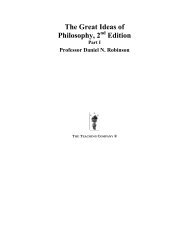English idioms in the first language and second language lexicon: a ...
English idioms in the first language and second language lexicon: a ...
English idioms in the first language and second language lexicon: a ...
Create successful ePaper yourself
Turn your PDF publications into a flip-book with our unique Google optimized e-Paper software.
Second Language Research 19,4 (2003); pp. 329–358<strong>English</strong> <strong>idioms</strong> <strong>in</strong> <strong>the</strong> <strong>first</strong> <strong>language</strong><strong>and</strong> <strong>second</strong> <strong>language</strong> <strong>lexicon</strong>: a dualrepresentation approachBeate Abel University of WuppertalIn two empirical studies, judgements that native speakers of German makeabout <strong>the</strong> decomposability of <strong>English</strong> <strong>idioms</strong> were <strong>in</strong>vestigated. Adecomposable idiom is an idiom whose <strong>in</strong>dividual components contribute toits figurative mean<strong>in</strong>g, whereas <strong>the</strong> constituents of a nondecomposable idiomdo not make such a contribution. The f<strong>in</strong>d<strong>in</strong>gs were analysed <strong>and</strong> comparedto native judgements. The Model of Dual Idiom Representation is<strong>in</strong>troduced <strong>in</strong> order to expla<strong>in</strong> <strong>the</strong> differences between <strong>the</strong> two groups. At<strong>the</strong> lexical level, <strong>the</strong> model postulates <strong>the</strong> parallel existence of idiom entries<strong>and</strong> constituent entries. The degree of decomposability <strong>and</strong> <strong>the</strong> frequencywith which <strong>the</strong> idiom is encountered determ<strong>in</strong>e its lexical representation. If<strong>the</strong>re is no idiom entry for a particular idiom, conceptual representationsare accessed dur<strong>in</strong>g comprehension. Because nonnative speakers encounter<strong>idioms</strong> less often than native speakers, <strong>the</strong> <strong>first</strong> <strong>language</strong> (L1) <strong>and</strong> <strong>second</strong><strong>language</strong> (L2) <strong>lexicon</strong> vary with regard to <strong>the</strong> number of idiom entries.I IntroductionIdioms such as back to square one, play with fire, pull someone’s leg,steal <strong>the</strong> show or with fly<strong>in</strong>g colours are expressions that abound <strong>in</strong><strong>English</strong> <strong>and</strong> are easily produced <strong>and</strong> understood by speakers of that<strong>language</strong>.Traditionally, <strong>idioms</strong> are described as fixed expressions, i.e., asphrases or sentences whose figurative mean<strong>in</strong>g is not clear from <strong>the</strong>literal mean<strong>in</strong>g of <strong>the</strong>ir <strong>in</strong>dividual constituents. 1 As a consequence,most authors have drawn a fundamental dist<strong>in</strong>ction between literal<strong>and</strong> figurative <strong>language</strong> <strong>and</strong> have assumed that <strong>idioms</strong> <strong>and</strong> <strong>the</strong>ir1The approach that dom<strong>in</strong>ated <strong>the</strong> early days of idiom research <strong>and</strong> established dist<strong>in</strong>ctionswas generative grammar. From a generative, i.e., syntactic po<strong>in</strong>t of view, <strong>the</strong> fact that anexpression is not <strong>in</strong>terpretable <strong>in</strong> a literal way necessarily leads to <strong>the</strong> assumption that it isa fixed (noncompositional) expression. More pragmatically oriented studies use <strong>the</strong> terms‘true <strong>idioms</strong>’ (Wood, 1986: II) or ‘pure <strong>idioms</strong>’ (Howarth, 1998: 28) to refer to <strong>the</strong> ‘idiomatic= fixed’ relationship <strong>and</strong> allow for o<strong>the</strong>r nonliteral phrases to be idiomatic but nonfixed at<strong>the</strong> same time.Address for correspondence: Beate Abel, Department of <strong>English</strong> / L<strong>in</strong>guistics (Fb A),University of Wuppertal, Gauss-Strasse 20, 42097 Wuppertal, Germany; email: abel@uniwuppertal.de© Arnold 2003 10.1191/0267658303sr226oaDownloaded from http://slr.sagepub.com at Shanghai Jiaotong University on March 7, 2009














